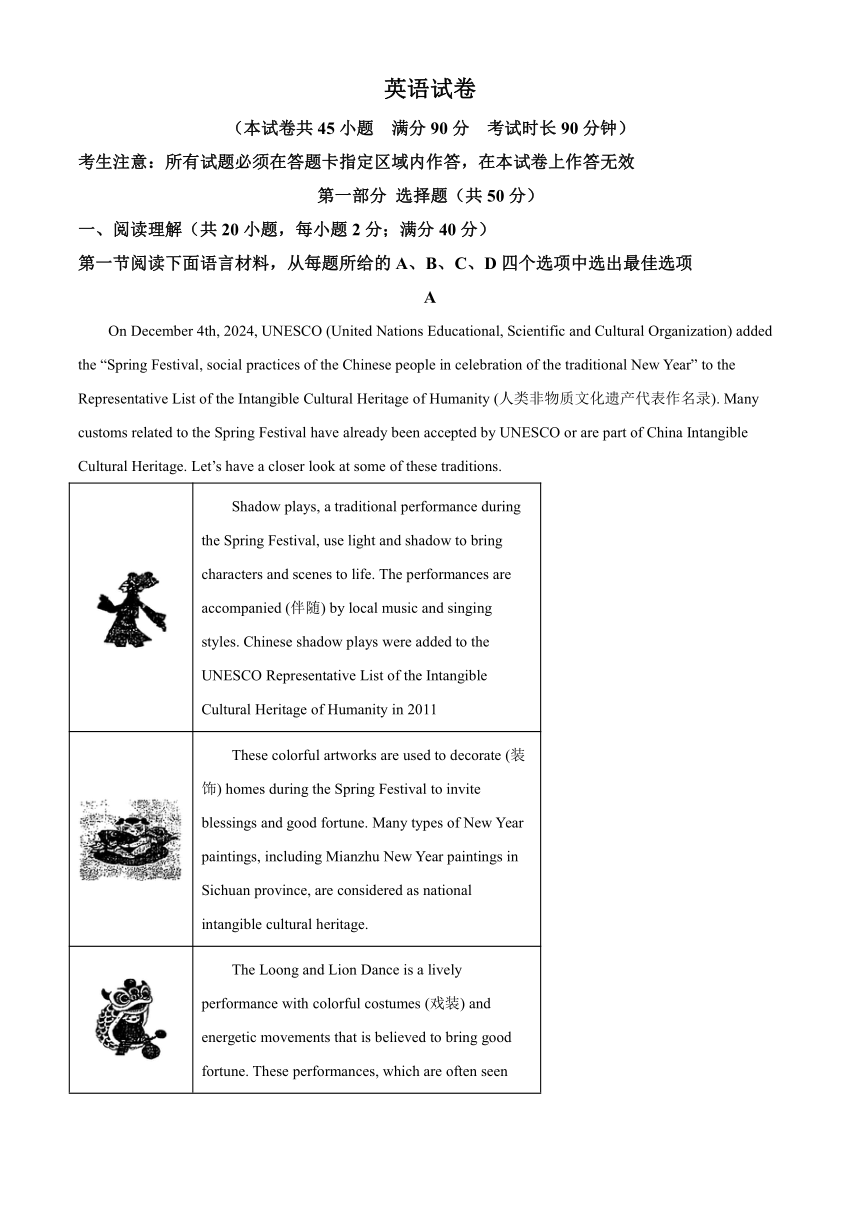
英语试卷 (本试卷共45小题 满分90分 考试时长90分钟) 考生注意:所有试题必须在答题卡指定区域内作答,在本试卷上作答无效 第一部分 选择题(共50分) 一、阅读理解(共20小题,每小题2分;满分40分) 第一节阅读下面语言材料,从每题所给的A、B、C、D四个选项中选出最佳选项 A On December 4th, 2024, UNESCO (United Nations Educational, Scientific and Cultural Organization) added the “Spring Festival, social practices of the Chinese people in celebration of the traditional New Year” to the Representative List of the Intangible Cultural Heritage of Humanity (人类非物质文化遗产代表作名录). Many customs related to the Spring Festival have already been accepted by UNESCO or are part of China Intangible Cultural Heritage. Let’s have a closer look at some of these traditions. Shadow plays, a traditional performance during the Spring Festival, use light and shadow to bring characters and scenes to life. The performances are accompanied (伴随) by local music and singing styles. Chinese shadow plays were added to the UNESCO Representative List of the Intangible Cultural Heritage of Humanity in 2011 These colorful artworks are used to decorate (装饰) homes during the Spring Festival to invite blessings and good fortune. Many types of New Year paintings, including Mianzhu New Year paintings in Sichuan province, are considered as national intangible cultural heritage. The Loong and Lion Dance is a lively performance with colorful costumes (戏装) and energetic movements that is believed to bring good fortune. These performances, which are often seen traveling around the world during the Spring Festival, were announced as national intangible cultural heritage by the State Council of China in 2006. Paper-cutting, a key part of Spring Festival decorations, is usually the symbol of wealth, happiness, and good fortune. It has deep cultural meanings and has its roots in China. In 2009, paper-cutting art was added to the UNESCO Representative List of the Intangible Cultural Heritage of Humanity. 1. What is the composition about A. About festival. B. About paper-cutting. C. About UNESCO. D. About traditions. 2. Which kind of art tradition can we find abroad A. Shadow plays. B. New Year paintings. C. The Loong and Lion Dance. D. Paper-cutting. 3. How long has Paper-cutting been in the UNESCO Representative List of the Intangible Cultural Heritage of Humanity A. For 14 years. B. For 15 years. C. For 16 years. D. For 17 years. 4. Where is the text probably from A. A science magazine. B. A cultural article. C. A travel guide. D. A sports newspaper. B Recent research showed nature can control our sense of time. Psychologist Ricardo Correia at the University of Turku in Finland found that being in nature may change how we experience time and, perhaps, even give us the sense of having plenty of time. Studies showed that people reported a sense of longer time when they were in nature compared to when they were in the environment of city. The way we experience time is shaped by our internal b ... ...
~~ 您好,已阅读到文档的结尾了 ~~